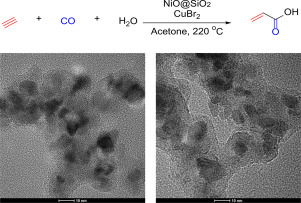Catalysis Communications ( IF 3.4 ) Pub Date : 2019-02-11 , DOI: 10.1016/j.catcom.2019.02.009 Hong Sub Choi , Ji Hoon Park , Jong Wook Bae , Jin Hee Lee , Tae Sun Chang

|
Acrylic acid and its ester derivatives are important chemicals utilized to synthesize numerous end products. Acrylic acid is industrially produced via propylene oxidation. We report in this study a nickel oxide-silica core-shell catalyst ([email protected]2) for acetylene hydroxycarbonylation as an alternative way to synthesize acrylic acid. [email protected]2 catalyst provided the higher turnover frequency and yield than commercial nickel oxide catalyst on acetylene hydroxycarbonylation. The carbon monoxide/acetylene ratio influenced more significantly to initial reaction rate than final acrylic acid yield. The silica shell protected the nickel oxide from sintering during reaction, however, the catalyst was deactivated by coke formation, attributed to acetylene decomposition.
中文翻译:

乙炔羟羰基化反应的氧化镍-二氧化硅核-壳催化剂
丙烯酸及其酯衍生物是用于合成众多最终产品的重要化学品。丙烯酸是通过丙烯氧化在工业上生产的。我们在这项研究中报告了乙炔羟羰基化的氧化镍-二氧化硅核-壳催化剂([email protected] 2),作为合成丙烯酸的另一种方法。[电子邮件保护] 2催化剂提供比乙炔羟基羰基化的商业氧化镍催化剂更高的转换频率和产量。一氧化碳/乙炔比对最终反应速率的影响比最终丙烯酸的收率影响更大。二氧化硅壳保护了反应期间氧化镍免于烧结,但是由于乙炔分解,催化剂因焦炭形成而失活。









































 京公网安备 11010802027423号
京公网安备 11010802027423号